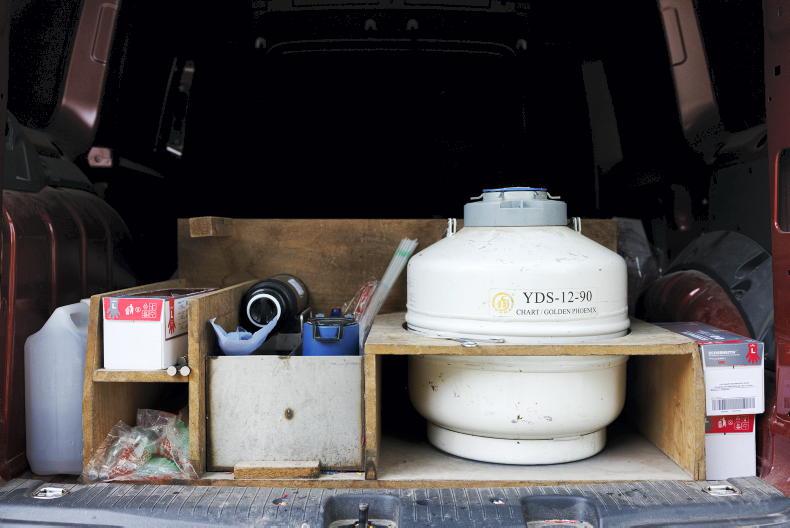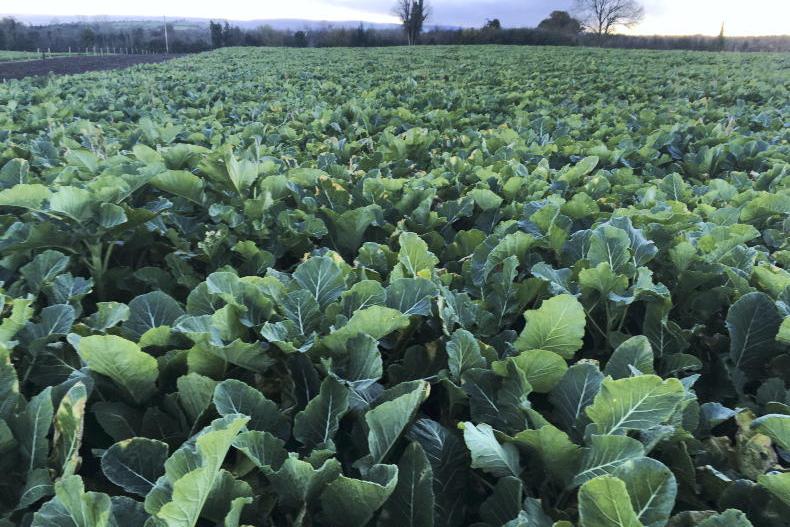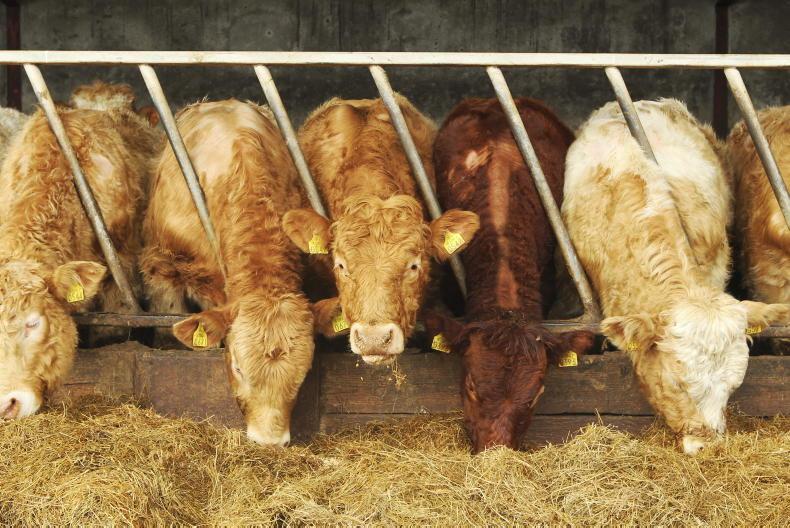The spring herd will come in for weaning and scanning later this month. It had a good season at grass and the cows are in good condition. Once scanned, the empty cows will be sold.
The calves will be moved round to Glenconglass and put onto a diet of silage and draff, with a little barley. Silage has yet to be analysed, so we haven’t finalised rations.
The rest of the cows will go out to some of the hill ground and be kept out there for as long as possible. While straw is cheaper, it is far simpler to feed them outside.
Hill herd
The hill herd will be scanned at the same time as the spring herd and any empties sold.
As this is a new enterprise, it is difficult to grow numbers if you are too hard on the animals, but there is little point in breeding from cows that are going to give problems.
There are also a couple of cows that have big teats who have been earmarked for selling.
The outside cows were looked at a few times a day and had a bale dropped into them
Calving outside means that having to suck calves is not practical. While this is a challenge, on the whole calving outside was great this spring.
The amount of labour that went into looking after similar numbers of calving cows inside and out was very different.
The outside cows were looked at a few times a day and had a bale dropped into them. The indoor cows needed feeding, bedding and looking at, not to mention more intervention at calving.
As it stands just now, there are 22 Highland cows with 21 calves and 16 Shorthorn crosses with 14 calves.
Autumn herd
Last year’s autumn calves are now getting 3kg a day of barley. They are earmarked for selling at the end of the month and we want them to look their best when they go into the ring.
Their mothers are away to start calving again. Like last year, they have been moved onto one of the small back hill fields here at home. Throughout the day they are strip-grazing one of the in-bye fields.
They are also close to the sheds if any need to come in for attention at calving.
They will be kept outside with their calves for as long as possible, before being brought into the sheds for winter. Like the steers, they will go onto a diet of silage, barley and draff for winter.
Sheep
The first lot of lambs went off fat last week. Forty-six were sold to an average of 20.5kg. The remainder are either on the Skyfall forage crop or grass.

Lambs eating Skyfall, a leafy stubble turnip.
When looking at performance last year, it was quite noticeable how much we were missing in output with store Blackie lambs.
With improved grazing management and fertility, coupled with the forage crop, we are aiming to finish most lambs, giving us a greater output for the enterprise.
Feed supply
After a marathon of silage making over summer, there is a large supply of both pit and baled silage. My father said he has never seen the pit so full at Auchriachan.
Likewise, at Glenconglass, we have nearly run out of space to stack silage bales in the yard.
The extra growth this summer coincided with a new ley having been undersown with Westerwolds, meaning a lot of grass has been conserved.
While there is plenty of fodder in the yard, the usual quantity of draff has been pitted. Summer pitting makes it a very cost-effective feed and it works well here.
Adviser comment by Robert Gilchrist: establishing the hill herd and future growth
With nearly three years of the project under their belt, it is great to see the Duffus family with a clear vision for the future.
One of the key aspects of this project is to create a viable long-term plan for the family, not just a three-year gloss.
The establishment of the hill herd has been the plan from day one, and with that group now standing at 38 cows to the bull this year, it is on the way to making up a significant part of the turnover of the business.
This group is targeted to expand to around 100 cows, all calving in spring. The cattle are not intended to come into sheds, instead they will be wintered on the hill in sheltered areas.
This year they will be fed silage to supplement what they get from the hill over winter.
In future they may not get silage, instead being supplemented with cow rolls through spells of poorer weather and pre-calving alongside the grazing.
Those Shorthorn-cross heifers will go back to another Shorthorn bull
It will be a self-replacing unit, with the Highland cows being bulled by either a Highland or a Shorthorn bull.
The Highland heifer calves will be used as replacements for the nucleus Highland herd. The Shorthorn-cross heifers will be used as the core of the main herd.
Those Shorthorn-cross heifers will go back to another Shorthorn bull. Surplus heifers from this will be carried to 21 months old and bulled to go into the existing autumn herd.
The in-bye spring herd will be phased out to give more space indoors for the autumn herd and reduce the workload in spring.
While the male calves from the hill herd will not be worth as much as the male calves from the in-bye herd, they will have incurred far less cost to get to the point of sale.
On the sheep front, numbers will be maintained around where they currently are for now.
Management changes, including weaning lambs earlier and growing forage crops, has increased the number being sold prime.
Were more of the flock to be moved onto the more productive in-bye land, this would not only improve the performance of the flock
However, there are still too many going missing from the hill, reducing profitability.
Were more of the flock to be moved onto the more productive in-bye land, this would not only improve the performance of the flock, it would also reduce the losses from the hill.
This can be achieved by the phasing out of the in-bye cow herd.
The glamping pods have brought a fantastic diversification for the business
Removing them means that there is no requirement for grass for bulling cows on, or for making silage over summer, freeing it up for sheep.
Finally, the glamping pods have brought a fantastic diversification for the business. The family’s journey with the pods has been difficult, but now that they are established and running, things are looking well.
The spring herd will come in for weaning and scanning later this month. It had a good season at grass and the cows are in good condition. Once scanned, the empty cows will be sold.
The calves will be moved round to Glenconglass and put onto a diet of silage and draff, with a little barley. Silage has yet to be analysed, so we haven’t finalised rations.
The rest of the cows will go out to some of the hill ground and be kept out there for as long as possible. While straw is cheaper, it is far simpler to feed them outside.
Hill herd
The hill herd will be scanned at the same time as the spring herd and any empties sold.
As this is a new enterprise, it is difficult to grow numbers if you are too hard on the animals, but there is little point in breeding from cows that are going to give problems.
There are also a couple of cows that have big teats who have been earmarked for selling.
The outside cows were looked at a few times a day and had a bale dropped into them
Calving outside means that having to suck calves is not practical. While this is a challenge, on the whole calving outside was great this spring.
The amount of labour that went into looking after similar numbers of calving cows inside and out was very different.
The outside cows were looked at a few times a day and had a bale dropped into them. The indoor cows needed feeding, bedding and looking at, not to mention more intervention at calving.
As it stands just now, there are 22 Highland cows with 21 calves and 16 Shorthorn crosses with 14 calves.
Autumn herd
Last year’s autumn calves are now getting 3kg a day of barley. They are earmarked for selling at the end of the month and we want them to look their best when they go into the ring.
Their mothers are away to start calving again. Like last year, they have been moved onto one of the small back hill fields here at home. Throughout the day they are strip-grazing one of the in-bye fields.
They are also close to the sheds if any need to come in for attention at calving.
They will be kept outside with their calves for as long as possible, before being brought into the sheds for winter. Like the steers, they will go onto a diet of silage, barley and draff for winter.
Sheep
The first lot of lambs went off fat last week. Forty-six were sold to an average of 20.5kg. The remainder are either on the Skyfall forage crop or grass.

Lambs eating Skyfall, a leafy stubble turnip.
When looking at performance last year, it was quite noticeable how much we were missing in output with store Blackie lambs.
With improved grazing management and fertility, coupled with the forage crop, we are aiming to finish most lambs, giving us a greater output for the enterprise.
Feed supply
After a marathon of silage making over summer, there is a large supply of both pit and baled silage. My father said he has never seen the pit so full at Auchriachan.
Likewise, at Glenconglass, we have nearly run out of space to stack silage bales in the yard.
The extra growth this summer coincided with a new ley having been undersown with Westerwolds, meaning a lot of grass has been conserved.
While there is plenty of fodder in the yard, the usual quantity of draff has been pitted. Summer pitting makes it a very cost-effective feed and it works well here.
Adviser comment by Robert Gilchrist: establishing the hill herd and future growth
With nearly three years of the project under their belt, it is great to see the Duffus family with a clear vision for the future.
One of the key aspects of this project is to create a viable long-term plan for the family, not just a three-year gloss.
The establishment of the hill herd has been the plan from day one, and with that group now standing at 38 cows to the bull this year, it is on the way to making up a significant part of the turnover of the business.
This group is targeted to expand to around 100 cows, all calving in spring. The cattle are not intended to come into sheds, instead they will be wintered on the hill in sheltered areas.
This year they will be fed silage to supplement what they get from the hill over winter.
In future they may not get silage, instead being supplemented with cow rolls through spells of poorer weather and pre-calving alongside the grazing.
Those Shorthorn-cross heifers will go back to another Shorthorn bull
It will be a self-replacing unit, with the Highland cows being bulled by either a Highland or a Shorthorn bull.
The Highland heifer calves will be used as replacements for the nucleus Highland herd. The Shorthorn-cross heifers will be used as the core of the main herd.
Those Shorthorn-cross heifers will go back to another Shorthorn bull. Surplus heifers from this will be carried to 21 months old and bulled to go into the existing autumn herd.
The in-bye spring herd will be phased out to give more space indoors for the autumn herd and reduce the workload in spring.
While the male calves from the hill herd will not be worth as much as the male calves from the in-bye herd, they will have incurred far less cost to get to the point of sale.
On the sheep front, numbers will be maintained around where they currently are for now.
Management changes, including weaning lambs earlier and growing forage crops, has increased the number being sold prime.
Were more of the flock to be moved onto the more productive in-bye land, this would not only improve the performance of the flock
However, there are still too many going missing from the hill, reducing profitability.
Were more of the flock to be moved onto the more productive in-bye land, this would not only improve the performance of the flock, it would also reduce the losses from the hill.
This can be achieved by the phasing out of the in-bye cow herd.
The glamping pods have brought a fantastic diversification for the business
Removing them means that there is no requirement for grass for bulling cows on, or for making silage over summer, freeing it up for sheep.
Finally, the glamping pods have brought a fantastic diversification for the business. The family’s journey with the pods has been difficult, but now that they are established and running, things are looking well.











SHARING OPTIONS